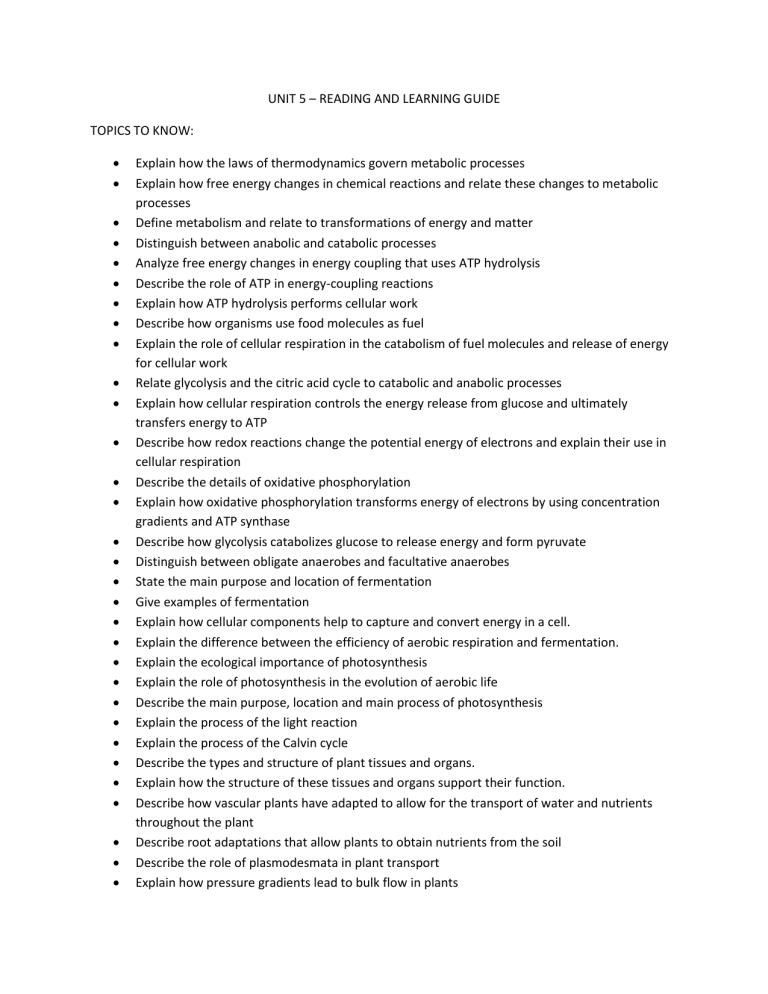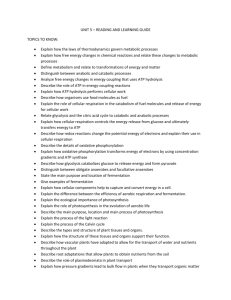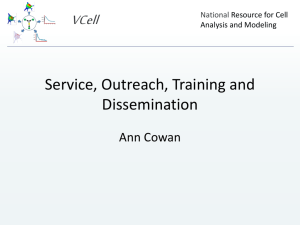UNIT 5 – READING AND LEARNING GUIDE TOPICS TO KNOW

UNIT 5 – READING AND LEARNING GUIDE
TOPICS TO KNOW:
Explain how the laws of thermodynamics govern metabolic processes
Explain how free energy changes in chemical reactions and relate these changes to metabolic processes
Define metabolism and relate to transformations of energy and matter
Distinguish between anabolic and catabolic processes
Analyze free energy changes in energy coupling that uses ATP hydrolysis
Describe the role of ATP in energy-coupling reactions
Explain how ATP hydrolysis performs cellular work
Describe how organisms use food molecules as fuel
Explain the role of cellular respiration in the catabolism of fuel molecules and release of energy for cellular work
Relate glycolysis and the citric acid cycle to catabolic and anabolic processes
Explain how cellular respiration controls the energy release from glucose and ultimately transfers energy to ATP
Describe how redox reactions change the potential energy of electrons and explain their use in
cellular respiration
Describe the details of oxidative phosphorylation
Explain how oxidative phosphorylation transforms energy of electrons by using concentration gradients and ATP synthase
Describe how glycolysis catabolizes glucose to release energy and form pyruvate
Distinguish between obligate anaerobes and facultative anaerobes
State the main purpose and location of fermentation
Give examples of fermentation
Explain how cellular components help to capture and convert energy in a cell.
Explain the difference between the efficiency of aerobic respiration and fermentation.
Explain the ecological importance of photosynthesis
Explain the role of photosynthesis in the evolution of aerobic life
Describe the main purpose, location and main process of photosynthesis
Explain the process of the light reaction
Explain the process of the Calvin cycle
Describe the types and structure of plant tissues and organs.
Explain how the structure of these tissues and organs support their function.
Describe how vascular plants have adapted to allow for the transport of water and nutrients throughout the plant
Describe root adaptations that allow plants to obtain nutrients from the soil
Describe the role of plasmodesmata in plant transport
Explain how pressure gradients lead to bulk flow in plants
Explain how minerals and water move through a plant via the xylem
Describe how stomata regulate water flow through a plant
Distinguish between the different mechanisms of transport in plants
Describe the nutrient needs of plants
Describe the benefits and composition of soil
Explain what metabolism is and how we measure it.
Describe basal metabolism rate and how researchers apply this information.
Describe how an organism’s size or activity level can influence metabolism.
Distinguish between torpor and true hibernation and relate these conditions to metabolic changes.
Explain how diet provides chemical energy to an animal and what the animal does with that energy.
Describe and define the various types of essential nutrients.
Describe how diet contributes the necessary building blocks for life’s processes.
Predict outcomes when diets are deficient in providing chemical energy, nutrients, or life’s building blocks.
Name and define the four basic stages of food processing.
Describe how food is mechanically and chemically digested in the stomach.
Describe the role of accessory organs in digestion.
Describe the processes of chemical digestion and absorption that occur in the small intestine.
Relate digestive tract adaptations to dietary needs.
Describe how both animals and the microbes they harbor can benefit one another.
Describe the purposes of a circulatory system in a complex organism.
Identify the basic components of the circulatory system.
Compare and contrast open and closed circulatory systems.
Distinguish between single and double circulation.
Trace the path of blood from contraction of the left ventricle to the right atrium.
Explain the role of valves in the heart and what happens if a valve malfunctions.
TEXT BOOK SECTIONS:
MODULES 23-31; 113; 115-117; 123; 144-152
ON-LINE SOURCES:
Great animation from leaf structure to photosynthesis: http://dendro.cnre.vt.edu/forestbiology/photosynthesis.swf
Photosynthesis: http://vcell.ndsu.nodak.edu/animations/photosynthesis/movie.htm
and http://vcell.ndsu.nodak.edu/animations/photosystemII/movie.htm
Oxidative phosphorylation animation: http://vcell.ndsu.nodak.edu/animations/atpgradient/movie.htm
And http://vcell.ndsu.nodak.edu/animations/etc/movie.htm
Circulatory system:
http://www.argosymedical.com/Circulatory/samples/animations/Heart/index.html
http://www.youtube.com/watch?v=AOiyjNFB0as
Bozeman Biology: http://www.bozemanscience.com/ap-biology/ #’s 012, 013
http://www.bozemanscience.com/cellular-respiration
http://www.bozemanscience.com/013-photosynthesis-and-respiration
http://www.bozemanscience.com/plant-nutrition-transport
http://www.bozemanscience.com/circulatory-system
http://www.bozemanscience.com/digestive-system
http://www.bozemanscience.com/respiratory-system
MATH:
Water potential
Standard error
Standard deviation
Temperature coefficient calculations
LABS:
Laboratory Investigation: 5 – Photosynthesis
Laboratory Investigation 6 – Cellular Respiration
(Laboratory Investigation 11 – Transpiration only as a handout)









